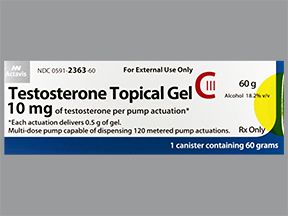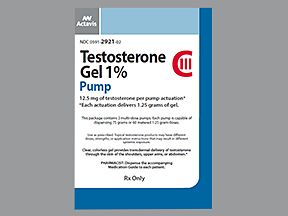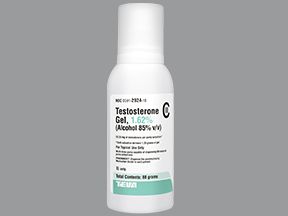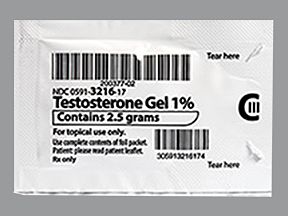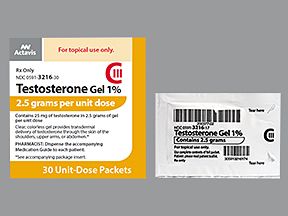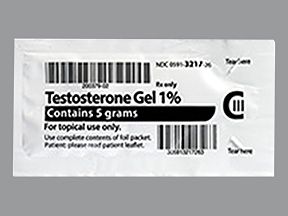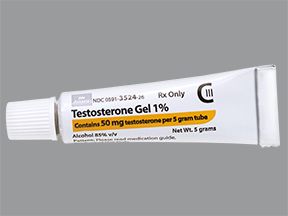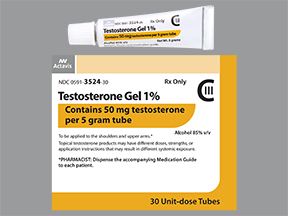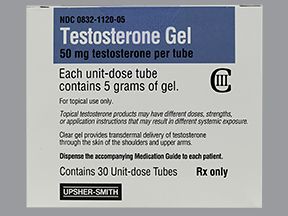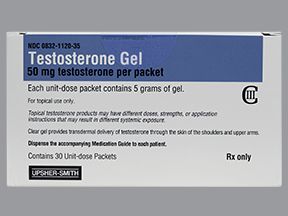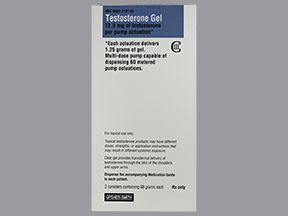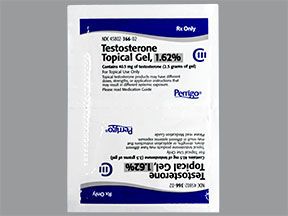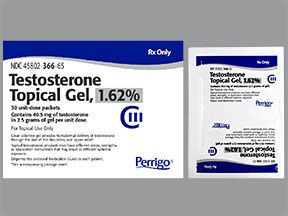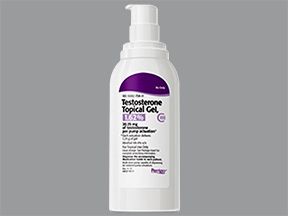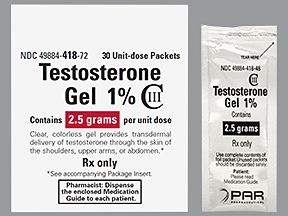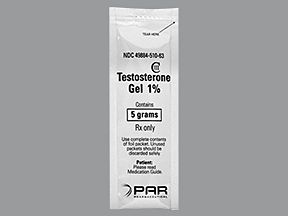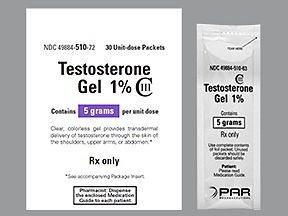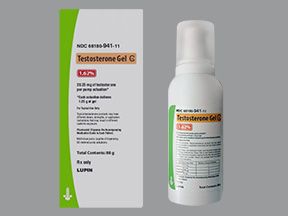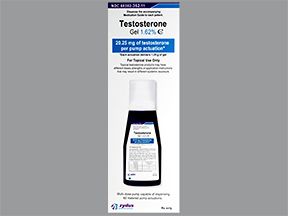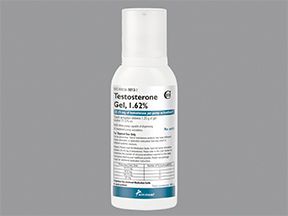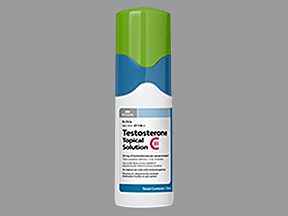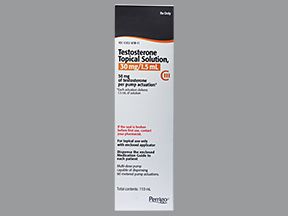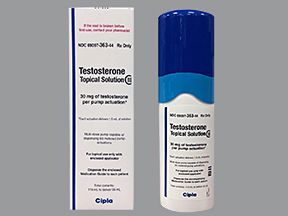Highlights for testosterone
- Testosterone transdermal patch is available as a brand-name drug. It’s not available as a generic drug. Brand name: Androderm.
- Testosterone comes in these forms: transdermal patch, topical gel, topical solution, nasal gel, and buccal tablet. It also comes as an implant that a healthcare provider inserts under your skin, and an oil that a healthcare provider injects into your muscle.
- Testosterone transdermal patch is used to treat males with hypogonadism. Males with this condition can’t make enough of the hormone testosterone.
- Heart attack or stroke warning: This drug may increase your risk of heart attack or stroke.
- Blood clots warning: Use of this drug may be related to an increased risk of pulmonary embolism (blood clots in your lungs) or deep vein thrombosis (blood clots in the deep veins of your legs).
- Misuse warning: Testosterone can be misused. There’s an increased risk of misuse if you take this drug at higher doses than your doctor prescribes, or if you use it along with other anabolic steroids. Misusing testosterone can lead to serious health problems. These include heart attack, heart failure, depression, and psychosis. Your doctor can tell you more about the risks of testosterone misuse.
Testosterone is a prescription drug. It comes in these forms: transdermal patch, topical gel, topical solution, nasal gel, and buccal tablet. It’s also available as an implant that’s inserted under your skin by a healthcare provider, and an oil that’s injected into your muscle by a healthcare provider.
The testosterone transdermal patch is available as the brand-name drug Androderm. It isn’t available as a generic drug.
Testosterone is a controlled substance. That means its use is regulated by the U.S. government.
Why it’s used
Testosterone is used to treat males with hypogonadism. Males with this condition can’t make enough of the hormone testosterone.
How it works
Testosterone belongs to a class of drugs called androgens. A class of drugs is a group of medications that work in a similar way. These drugs are often used to treat similar conditions.
This drug works by adding testosterone to your body.
Testosterone transdermal patch doesn’t cause drowsiness, but it can cause other side effects.
More common side effects
Some of the more common side effects that can occur with use of testosterone transdermal patch include:
- redness, irritation, burning, and blisters at the application site
- back pain
If these effects are mild, they may go away within a few days or a couple of weeks. If they’re more severe or don’t go away, talk to your doctor or pharmacist.
Serious side effects
Call your doctor right away if you have serious side effects. Call 911 if your symptoms feel life-threatening or if you think you’re having a medical emergency. Serious side effects and their symptoms can include the following:
- Enlarged prostate. Symptoms can include:
- increased urination at night
- trouble starting your urine stream
- urinating many times during the day
- urinary urgency (the urge to go to the bathroom right away)
- urine accidents
- being unable to pass urine
- weak urine flow
- Prostate cancer
- Blood clots in your lungs or the veins of your legs. Symptoms can include:
- leg pain, swelling, or redness
- trouble breathing
- chest pain
- Heart attack or stroke
- Lowered sperm count (can occur when large doses of the drug are taken)
- Swelling of your ankles, feet, or body
- Enlarged or painful breasts
- Sleep apnea (breathing problems during sleep)
- Erections that last longer than four hours
Disclaimer: Our goal is to provide you with the most relevant and current information. However, because drugs affect each person differently, we cannot guarantee that this information includes all possible side effects. This information is not a substitute for medical advice. Always discuss possible side effects with a healthcare provider who knows your medical history.
Testosterone transdermal patch can interact with other medications, vitamins, or herbs you may be taking. An interaction is when a substance changes the way a drug works. This can be harmful or prevent the drug from working well.
To help avoid interactions, your doctor should manage all of your medications carefully. Be sure to tell your doctor about all medications, vitamins, or herbs you’re taking. To find out how this drug might interact with something else you’re taking, talk to your doctor or pharmacist.
Examples of drugs that can cause interactions with testosterone are listed below.
Interactions that can increase the risk of side effects
Taking testosterone with certain drugs raises your risk of side effects from these drugs. Examples of these drugs include:
- Adrenocorticotropic hormone or corticosteroids. Taking testosterone with these drugs may increase fluid build-up (edema) in your body. Your doctor will monitor you closely for fluid build-up, especially if you have heart, liver, or kidney disease.
Interactions that may require dosage changes
Examples of these drugs include:
- Insulin. Taking testosterone may decrease your blood sugar level. If you’re taking testosterone with insulin, your doctor may need to decrease your insulin dosage.
- Blood thinners such as warfarin, apixaban, dabigatran, or rivaroxaban. Taking testosterone can change how your blood clots. Your doctor may need to monitor more closely how your blood-thinning medications are working.
Disclaimer: Our goal is to provide you with the most relevant and current information. However, because drugs interact differently in each person, we cannot guarantee that this information includes all possible interactions. This information is not a substitute for medical advice. Always speak with your healthcare provider about possible interactions with all prescription drugs, vitamins, herbs and supplements, and over-the-counter drugs that you’re taking.
This drug comes with several warnings.
Warnings for men with certain health conditions
For men with liver disease: If you have liver disease, taking this drug may cause your body to retain fluid, causing swelling (edema).
For men with heart disease: If you have heart disease, testosterone may cause salt and water retention. This may cause swelling (edema) with or without heart failure.
For men with kidney disease: If you have kidney disease or a history of kidney disease, taking this drug may cause your body to retain fluid, causing swelling (edema).
For men with breast cancer: You should not use this drug if you have breast cancer. Taking this drug could make your cancer worse.
For men with prostate cancer: You should not use this drug if you have prostate cancer. Taking this drug could make your cancer worse.
For men who are overweight: If you’re overweight, taking this drug may make breathing while you sleep more difficult. It could lead to sleep apnea.
For men with diabetes: Taking this drug may decrease your blood sugar levels. If you treat your diabetes with insulin, your doctor may need to decrease your insulin dosage.
For men with enlarged prostate: This drug may make the symptoms of your enlarged prostate worse. Your doctor will monitor you for worsening symptoms while you take this drug.
Warnings for other groups
For pregnant women: This drug is not prescribed for women. Testosterone is a category X pregnancy drug. Category X drugs should never be used during pregnancy.
For women who are breastfeeding: This drug is not prescribed for women. It should not be used in women who are breastfeeding. It’s not known how much testosterone passes into human breast milk, but this drug could cause serious negative reactions in a child who is breastfed. It could also cause problems with the amount of milk the mother is able to produce.
For seniors: Testosterone replacement should not be used in seniors with andropause (age-related decreases in testosterone). There is not enough long-term safety information available to assess the risks for seniors of prostate cancer and cardiovascular disease or worsening of enlarged prostate while taking this drug.
For children: This medication has not been studied in children. It should not be used in children younger than 18 years. Use in children may cause their bones to mature more quickly without increasing height. This may cause a child to stop growing sooner than expected, and the child may be shorter.
All possible dosages and drug forms may not be included here. Your dosage, drug form, and how often you take the drug will depend on:
- your age
- the condition being treated
- the severity of your condition
- other medical conditions you have
- how you react to the first dose
Drug form and strengths
Brand: Androderm
- Form: transdermal patch
- Strengths: 2 mg, 4 mg
Dosage for primary hypogonadism
Adult dosage (ages 18 years and older)
- Typical starting dosage: One 4-mg transdermal patch applied each night to your back, stomach, upper arm, or thigh.
- Dosage adjustments: Your doctor may adjust your dosage depending on your morning testosterone levels. Typical maintenance dosages are 2–6 mg per day.
- Maximum dosage: 6 mg per day.
Child dosage (ages 0–17 years)
This medication should not be used in children younger than 18 years. Use in children may cause bones to mature more quickly without increasing height. This may cause a child to stop growing sooner than expected, which may result in a shorter adult height.
Dosage for hypogonadotropic hypogonadism
Adult dosage (ages 18 years and older)
- Typical starting dosage: One 4-mg transdermal patch applied each night to your back, stomach, upper arm, or thigh.
- Dosage adjustments: Your doctor may adjust your dosage depending on your morning testosterone levels. Typical maintenance dosages are 2–6 mg per day.
- Maximum dosage: 6 mg per day.
Child dosage (ages 0–17 years)
This medication should not be used in children younger than 18 years. Use in children may cause bones to mature more quickly without increasing height. This may cause a child to stop growing sooner than expected, which may result in a shorter adult height.
Disclaimer: Our goal is to provide you with the most relevant and current information. However, because drugs affect each person differently, we cannot guarantee that this list includes all possible dosages. This information is not a substitute for medical advice. Always speak with your doctor or pharmacist about dosages that are right for you.
Testosterone transdermal patch is used for long-term treatment. It comes with serious risks if you don’t take it as prescribed.
If you stop taking the drug suddenly or don’t take it at all: The symptoms from your condition won’t be treated.
If you miss doses or don’t take the drug on schedule: Your medication may not work as well or may stop working completely. For this drug to work well, a certain amount needs to be in your body at all times.
If you take too much: You could have dangerous levels of the drug in your body.
If you think you’ve taken too much of this drug, call your doctor or seek guidance from the American Association of Poison Control Centers at 1-800-222-1222 or through their online tool. But if your symptoms are severe, call 911 or go to the nearest emergency room right away.
What to do if you miss a dose: Take your dose as soon as you remember. But if you remember just a few hours before your next scheduled dose, take only one dose. Never try to catch up by taking two doses at once. This could result in dangerous side effects.
How to tell if the drug is working: Your symptoms of low testosterone should get better.
Keep these considerations in mind if your doctor prescribes testosterone for you.
General
- Apply the testosterone patch at the same time each day.
Storage
- Store testosterone transdermal patches at room temperature between 68°F and 77°F (20°C and 25°C).
- Keep them away from light.
- Apply the patch to your skin right after you open the protective pouch. Don’t store the patch after its protective pouch has been opened. If you open a patch and don’t need to use it, throw it away.
- Discard used patches in a place where children and pets can’t get to them.
Refills
A prescription for this medication is refillable up to five times in six months since it’s a Schedule III controlled substance. Your doctor will write the number of refills authorized on your prescription.
Travel
When traveling with your medication:
- Always carry your medication with you. When flying, never put it into a checked bag. Keep it in your carry-on bag.
- Don’t worry about airport X-ray machines. They can’t harm your medication.
- You may need to show airport staff the pharmacy label for your medication. Always carry the original prescription-labeled container with you.
- Don’t put this medication in your car’s glove compartment or leave it in the car. Be sure to avoid doing this when the weather is very hot or very cold.
Self-management
- Apply the patch each night to your back, stomach, upper arm, or thigh.
- Remove the previous day’s patch before applying a new one.
- Don’t use the same application site twice in 7 days.
- Wait at least 3 hours after you apply the patch before you shower, swim, or wash the application site.
Clinical monitoring
Your doctor may do tests while you take this drug. These tests include:
- Hemoglobin and hematocrit test: Your doctor may check your blood for an increased amount of red blood cells.
- Cholesterol level tests: Your doctor may check your blood cholesterol because testosterone may increase your cholesterol level.
- Liver function tests: Your doctor may check how well your liver is working.
- Testosterone level tests: Your doctor may monitor your testosterone levels to make sure your dosage is correct.
- Prostate exam and prostate-specific antigen (PSA) tests: If you’re older, your doctor may check your prostate and your PSA levels to make sure your prostate is healthy.
Availability
Not every pharmacy stocks this drug. When filling your prescription, be sure to call ahead to make sure your pharmacy carries it.
Prior authorization
Many insurance companies require a prior authorization for this drug. This means your doctor will need to get approval from your insurance company before your insurance company will pay for the prescription.
There are other drugs available to treat your condition. Some may be better suited for you than others. Talk to your doctor about other drug options that may work for you.
Disclaimer: Healthline has made every effort to make certain that all information is factually correct, comprehensive, and up-to-date. However, this article should not be used as a substitute for the knowledge and expertise of a licensed healthcare professional. You should always consult your doctor or other healthcare professional before taking any medication. The drug information contained herein is subject to change and is not intended to cover all possible uses, directions, precautions, warnings, drug interactions, allergic reactions, or adverse effects. The absence of warnings or other information for a given drug does not indicate that the drug or drug combination is safe, effective, or appropriate for all patients or all specific uses.

